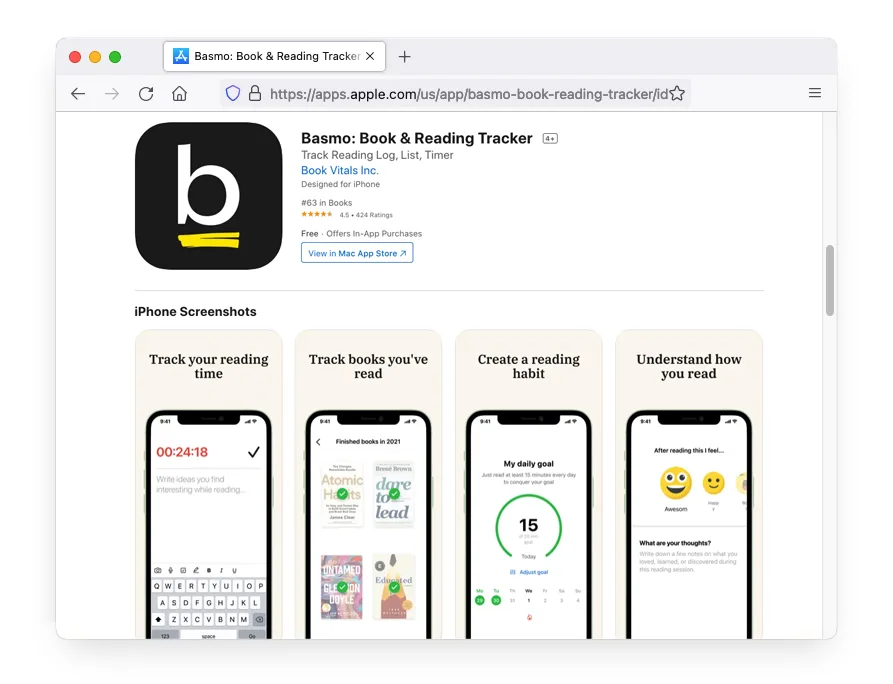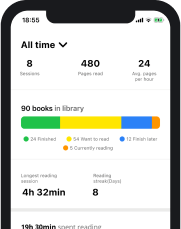While reading is a fun and rewarding activity, taking advantage of the full set of benefits it can provide us with requires a certain level of dedication and organization from our side. Whether it’s worth it or not is a clear no-brainer since it’s obvious that the advantages of being a reader outweigh any drawbacks by far.
Being an organized reader will help us read more, retain more information and take full advantage of the experience. And it all starts with a simple reading schedule.
If you’re wondering how to make a reading schedule and how important it really is for your reading experience and results, you’re in the right place.
Why is it important to have a reading schedule?
Before we start exploring different strategies for developing a reading schedule, it’s important to make sure that we are on the same page in regards to the importance of having one.
First of all, if you’re wondering if having a reading schedule is actually important, the answer is a resounding yes. Having a schedule brings some structure to your reading habits and has a major impact on how seriously you take this hobby you have.
Here’s a couple of the most relevant reasons why having a reading schedule is essential.
Our busy life
Probably one of the most obvious reasons why a book reading plan is important nowadays is the fast paced lives we live. We spend more time working than ever before, more time commuting to and from work than ever before, and everything around us moves at a speed that makes us wonder day after day if we’re going to be able to keep up.
Between work, raising children and keeping the house in order, it’s hard to ever find the time to read naturally. We rarely, if ever, get bored nowadays and finding time for ourselves is a luxury few of us can afford.
Having a reading schedule is one of the few options we have left for making sure that we make time for reading.
Distractions are all around
The rise of social media and the constant connectivity to our virtual lives comes at a price, despite being a fun part of our life. That price is the constant battle for our attention all these apps undertake on a daily basis. Sadly, most of the time they win.
Having a minute to yourself is more often than we like to admit interrupted by a notification on our smartphone. Whether it’s a work email, an instant message from a friend or a social media notification letting us know something completely insignificant happened, our phone buzzing is a sure way of moving our attention from whatever we were doing, to the smartphone.
Having a clear reading schedule implies that we impose certain rules and limits as well. One hour of reading every day with the notifications turned off on our phones is usually a great way to disconnect, but a schedule is essential for making this work and starting to incorporate it into our daily routine.
To read more
Like with pretty much anything else in life, reading requires you to be organized if you want to achieve your full potential. If you’re anything like me and don’t like doing anything halfheartedly, structuring your reading sessions and doing things right will be a necessity.
Apart from using reading lists, keeping a reading journal, notes and everything else that is important for healthy reading habits, having a schedule is also essential. By allowing yourself to waste no time, you will end up reading more even though at first it may feel otherwise.
To be more mindful about your reading
Some say that mindfulness is the key to happiness. While it’s not my job to agree or disagree with that statement, what I can tell you for sure is that being mindful of your reading makes a huge difference to how you approach reading and what benefits you can enjoy.
Being mindful about reading means that you are constantly aware of your reading habits, how much you read, what you like and dislike, and you are basically in total awareness about all the aspects around your reading. By adding a structure to your reading session and scheduling them according to your daily routine, you achieve the first step towards mindful reading.
The simple fact that you put some thought into deciding the days and time of day when it would be best for you to schedule your reading session puts you at an advantage.
To make sure you don’t slip off the reading wagon completely
Like I was mentioning earlier, finding the time and the right mood to read nowadays becomes harder and harder from one year to another. It’s a lot easier to stop reading completely for many of us than it is to keep our reading habits alive.
That is why sometimes, especially during more difficult or busy times, using a more forceful approach to our reading habits is not only useful, but in many cases, necessary. If we let ourselves get overwhelmed by our hectic lives and become more prone to watching TV or pointlessly scrolling on our phones, we are on a slippery slope that leads to completely reading-free lives. And we all know that it would be a tragedy.
Forcing our hand and pushing ourselves to read even when we don’t necessarily feel like it keeps us engaged in this amazing hobby of ours and has the potential of keeping our interest for books and reading alive.
If we set a schedule to read as little as 20 minutes every day, even if it’s a simple, fun and easy book, we are already winning. And in time, as our lives get back to normal and the rhythm slows back down, we can increase the length and difficulty of our reading sessions.
But we should never ever stop. Even if it means to force ourselves to a certain extent, reading should remain a part of our daily routine.
How to make a reading schedule and stick to it?
Now that we understand the importance of having one, it’s time to learn how to make a reading schedule and even more importantly, how to stick to it.
While it may seem like a straightforward and pretty basic thing to do, finding the right combination of factors to make a schedule to work for you may require a bit more insight than you would expect.
Since we are all about structuring and bringing order to chaos, we find it important for you to follow a couple of steps if you want to find the right way of creating a reading schedule and sticking to it.
Create your reading schedule in four easy steps
While the whole process of creating your reading schedule may seem a bit overwhelming at first, the great news is that there is a tool out there that can help you every step of the way: Basmo, the best reading tracking app. It’s not a reading schedule generator and doesn’t only act as a book reading schedule app, it does a whole lot more.

But first, let’s have a look at the four steps that can guide you to a successful scheduling of your reading sessions and how Basmo can help.
Step one: Understand your goals
Our four step plan to creating the perfect reading schedule starts with a deep understanding of your starting point. What kind of reader are you?
Take a close look at your existing reading habits and see if you are a casual reader who only reads from time to time and has no real idea about preferences and how to choose the book to start with or are you a passionate reader with a clear picture of your reading level and preferences.
Understanding your condition and being mindful of your current reading habits is the first step towards creating your reading schedule.
Basmo allows you to set reading goals. Basmo gives you the option to set daily goals for time spent reading or even yearly goals for the number of books you want to have read by the time the year is over.
To do this, you just need to tap the Goals tab on the bottom of the screen when you open the app and you will be able to easily set your daily or yearly goal by tapping “Adjust goal” and selecting the desired values.
Step two: Plan your reading sessions
Once you become aware of your starting point, it’s time to start planning. Ask yourself, where do you want your reading habits to be one year from now? How do you see yourself as a reader?
Now is the time to decide what your goals are, how much you would like to spend reading every day or how many books you would like to have read by the time the year has passed.
Also, it’s important to take a close look at your daily schedule before implementing your reading sessions. See what days of the week you are most likely to be able to read, what time of day would work for you best. Decide if you would like to be a night reader or a morning reader by comparing the benefits of both.
You can use Basmo to create your actual schedule: while having your reading schedule written on paper and taped to your fridge may work as well, Basmo comes with a better solution. An in-app functionality that allows you to choose the days of the week you want to schedule your reading sessions in and even different times of day for your sessions.
All you need to do is tap on Schedule Reading within the book you are reading. Once the scheduler opens, you will be able to select the days of the week when you plan to read by tapping on them (a minimum of three days of the week) and then the reading hours.
Step three: Act according to your plans
It’s time to put your plans in motion. Put your goals and reading schedule on paper and start working your way towards your goals by following the schedule you created. You will have a chance to analyze how well the schedule is working for you, how you feel with this schedule and take a look at some of your results.
It’s important to make the effort of sticking to your schedule for at least a couple of weeks before you can even start thinking about deciding whether it is working for you and adjusting it.
Basmo will make sure you stick to your schedule: Creating your reading schedule with Basmo comes with the added benefit of getting reminders on your smartphone for every upcoming scheduled reading session. That way there is no chance you can forget about it even if you don’t constantly check the schedule.
Step four: Analyze results and adapt your strategy
After a couple of weeks of sticking to your reading schedule, you can take a step back and analyze your progress. How many scheduled reading sessions did you stick to? How much closer to your reading goals are you now? Is there a particular day of the week when you can’t seem to stick to your schedule?
Take all these into account and see what adjustments you can make. Be mindful and realistic and always be aware that what you are doing is only benefiting you.
Basmo will tell you how you’re doing: using comprehensive statistics and progress tracking animations, Basmo will help you keep your evolution under control, showing you how you’re doing and giving you the right information to adjust your schedule and perfect it.
There’s a couple of other small details you should always be aware of in order to set the right schedule and manage to stick to it.
Find what motivates you to read
You need to have the right mindset in order to be successful and that starts with the right motivation. Try to find the thing that motivates you to read. Is it the health benefits? Do you want to be smarter? More compassionate?
Only you can answer these questions and the sooner you manage to find the true motivation for your action, the sooner you will start working your way towards success.
Be realistic
It’s easy to become overenthusiastic at first and that usually ends in disappointment and a major setback from achieving your goals.
Try to be realistic with your reading goals, don’t try to overachieve. It’s better to set yourself lower goals at first and exceed your own expectations than the other way around.
Conclusion
As you can see, creating a reading schedule is both important and difficult, especially if you don’t follow a couple of easy steps and have the right mindset and motivation.
Luckily for you, you now have all the right information and a tool that can make things a lot easier for you. And if you decide that you need a reading schedule maker, keep in mind that Basmo is the ultimate reading tracking app, but it can also be a great reading planner, reading schedule app and a great all-rounder when it comes to solutions for the modern reader.







